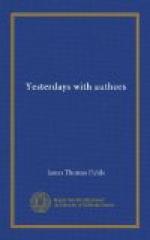“Stand back, my Lord, and let the coffin pass.”
On the 21st of August, 1820, No. 1 of “The Spectator, edited by N. Hathorne,” neatly written in printed letters by the editor’s own hand, appeared. A prospectus was issued the week before, setting forth that the paper would be published on Wednesdays, “price 12 cents per annum, payment to be made at the end of the year.” Among the advertisements is the following:—
“Nathaniel Hathorne
proposes to publish by subscription a NEW
EDITION of the MISERIES OF
AUTHORS, to which will be added a SEQUEL,
containing FACTS and REMARKS
drawn from his own experience.”
Six numbers only were published. The following subjects were discussed by young “Hathorne” in the Spectator,—“On Solitude,” “The End of the Year,” “On Industry,” “On Benevolence,” “On Autumn,” “On Wealth,” “On Hope,” “On Courage.” The poetry on the last page of each number was evidently written by the editor, except in one instance, when an Address to the Sun is signed by one of his sisters. In one of the numbers he apologizes that no deaths of any importance have taken place in the town. Under the head of Births, he gives the following news, “The lady of Dr. Winthrop Brown, a son and heir. Mrs. Hathorne’s cat, seven kittens. We hear that both of the above ladies are in a state of convalescence.” One of the literary advertisements reads:—
“Blank Books made and for sale by N. Hathorne.”
While Hawthorne was yet a little fellow the family moved to Raymond in the State of Maine; here his out-of-door life did him great service, for he grew tall and strong, and became a good shot and an excellent fisherman. Here also his imagination was first stimulated, the wild scenery and the primitive manners of the people contributing greatly to awaken his thought. At seventeen he entered Bowdoin College, and after his graduation returned again to live in Salem. During his youth he had an impression that he would die before the age of twenty-five; but the Mannings, his ever-watchful and kind relations, did everything possible for the care of his health, and he was tided safely over the period when he was most delicate. Professor Packard told me that when Hawthorne was a student at Bowdoin in his freshman year, his Latin compositions showed such facility that they attracted the special attention of those who examined them. The Professor also remembers that Hawthorne’s English compositions elicited from Professor Newman (author of the work on Rhetoric) high commendations.
When a youth Hawthorne made a journey into New Hampshire with his uncle, Samuel Manning. They travelled in a two-wheeled chaise, and met with many adventures which the young man chronicled in his home letters, Some of the touches in these epistles were very characteristic and amusing, and showed in those early years his quick observation and descriptive power. The travellers “put up” at Farmington, in order to rest over Sunday. Hawthorne writes to a member of the family in Salem: “As we were wearied with rapid travelling, we found it impossible to attend divine service, which was, of course, very grievous to us both. In the evening, however, I went to a Bible class, with a very polite and agreeable gentleman, whom I afterwards discovered to be a strolling tailor, of very questionable habits.”




